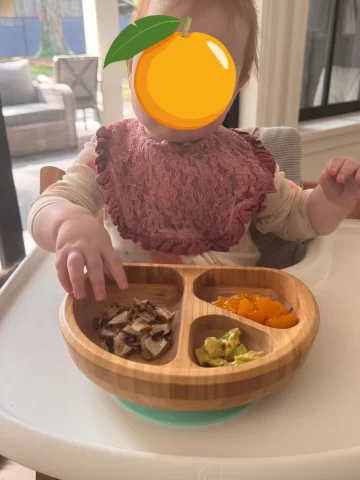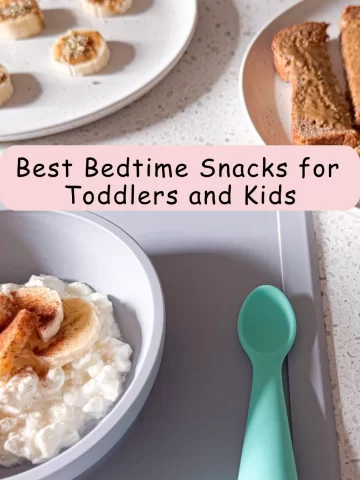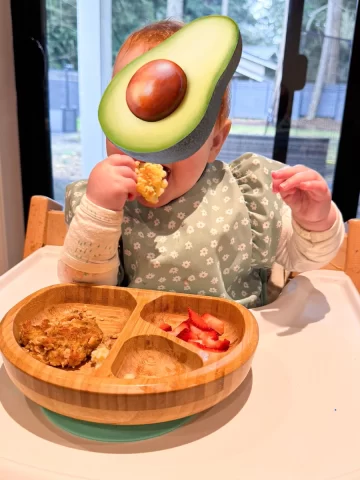When can kids start getting involved with cooking in the kitchen!? Read on to learn all about cooking with toddlers and kids and age-appropriate tasks to involve your child in the kitchen!
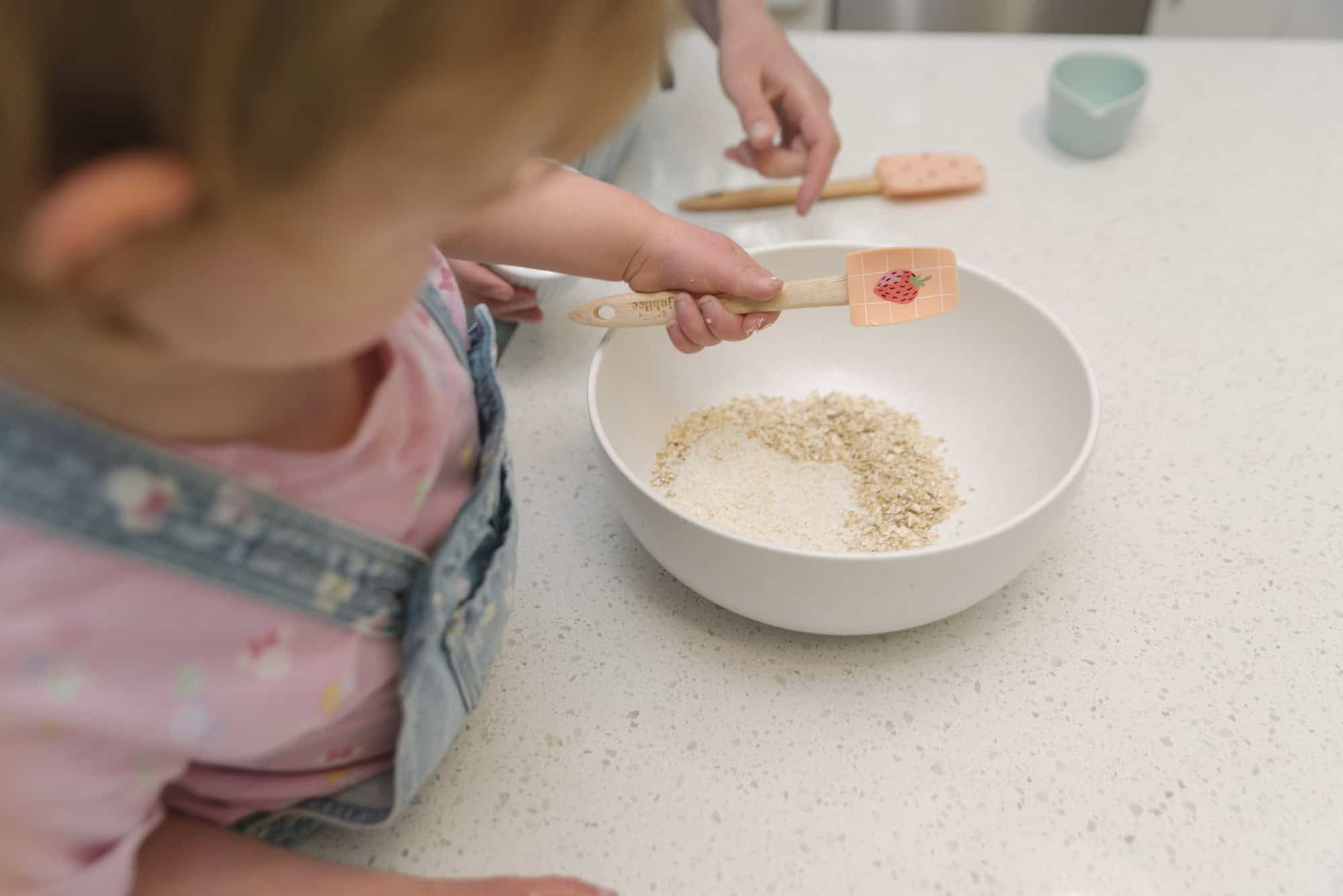
Save this recipe!
Jump to:
- Benefits for Involving Toddlers and Kids in Meal Prep
- Quick Tips for Kids Cooking in the Kitchen
- Setting Up a Child-Friendly Cooking Station
- Age-Appropriate Kitchen Activities for Kids
- Kitchen Activities for Toddlers (Ages 2-3)
- Kitchen Activities for Preschoolers (Ages 4-5)
- Kitchen Activities for Early School Age (Ages 6-8)
- Kitchen Activities for Preteens (Ages 9-12)
There are so many options, and benefits, for involving your child in the kitchen even at a young age. Both my kids loved watching me cook in the kitchen when they were babies and could face out in the carrier!
Kids learn by watching and doing! When you invite them to join you in meal prep, you’re helping them gain confidence and practical skills that will benefit them later in life. By getting hands-on experience in the kitchen, your child will gain exposure to food in a non-pressured way; supporting their curiosity and openness to trying new foods. And BONUS, toddlers love being involved in meaningful work, so giving them some tasks to help with meal prep will help them build independence.
As a dietitian, I appreciate how supportive it can be to involve toddlers and kids in the kitchen. However, as a mom, I also get the reality of this and know that sometimes we need to lower our expectations as to what this might look like! Sometimes involving your child in food prep can add a bit more stress and maybe we just don’t need the extra stress on that particular day – please know that is totally ok!
Benefits for Involving Toddlers and Kids in Meal Prep
Involving children in the kitchen is more than just a fun activity; it offers numerous benefits:
- Increased Exposure: Repeated exposure to different foods can help kids become more accepting of them. The more they see, touch, and interact with food, the more likely they are to try it.
- Boosted Confidence: Participating in meal prep can boost your child’s confidence and give them a sense of accomplishment. They become proud of contributing to a family meal.
- Enhanced Learning: Cooking offers numerous learning opportunities, from counting and measuring, to understanding textures and colours. It can also improve their fine motor skills.
- Family Bonding: Cooking together is a great way to bond together. It creates lasting memories and traditions.
- Inspires Creativity: Cooking provides a space for kids to explore their inner chef and experiment with flavour combinations, textures, and the presentation of food. They can learn not only how to follow recipes, but also how to start to make them their own and take ownership in the food they prepare!
Quick Tips for Kids Cooking in the Kitchen
A little preparation can go a long with in making cooking with your child in the kitchen a smoother experience! Here are some tips:
- Plan out either what you are making or what task your child is going to be involved with ahead of time.
- Get any ingredients and specific tasks for your child set up ahead of time.
- Ensure your child’s cooking station is safe. Keep them away from anything hot or sharp.
Setting Up a Child-Friendly Cooking Station
This tip is huge. When you have a safe kitchen station setup for your child it will promote independence for your child (which of course toddlers love) and it will reduce stress for yourself!
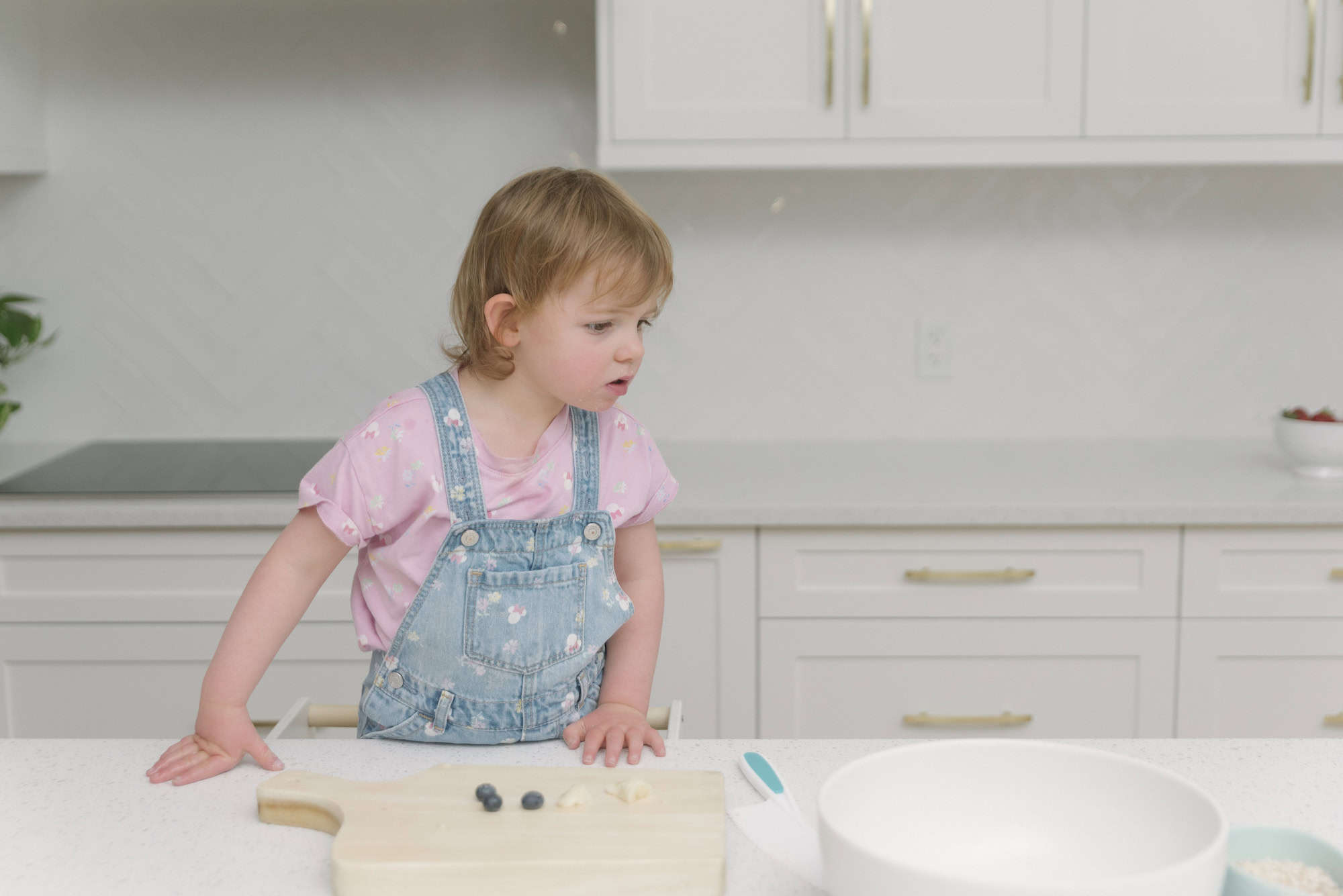
- Choose a safe, accessible spot: Find a place in your kitchen where your child can comfortably reach their tools and ingredients. If you have a kitchen tower, you can set this up at a spot at your counter. Or, if you have a lower cabinet or basket, you can set up their own spot closer to the ground.
- If you are bringing them up to the counter, ensure you are using a sturdy step stool or learning tower: I love learning toddler towers to help bring up a child to the counter. I encourage you to find one that has side supports to help prevent falls, and some even have a panel you can slide down at the back! We got one off Etsy which also turns into a toddler-friendly table and has a slide – Because who doesn’t love a slide!? (*note, we do not use the slide when cooking in the kitchen!)
- Set up the tools they need: Set up some bowls, a small cutting board, any stir spoons needed and any child safe tools such as a crinkle cutter or child safe knife. Knowing they have a dedicated spot also helps support their focus and engagement!
- Use child safe ingredients: Now every child will be at a different level developmentally, but when starting out, I love using ingredients that if they do happen to go in a child’s mouth, I’m not panicked about it. So start off with recipes that are prepared in a child-safe way and avoid any raw or unsafe foods. As a child gets older, it is a great opportunity to talk to them about which foods to avoid “testing” while cooking with you in the kitchen. Of course some foods we will want them to test and this can be a great way for children to try out new foods in a non-pressured way!
- Keep ingredients in child-friendly containers: You can either portion them out ahead of time or support your child with being able to access the ingredients at their station. Think lightweight containers, and easy lids to unscrew. You can also create simple labels or colourful stickers to indicate what ingredient goes in what container! We love visual charts here, so for young children, you could even create a visual chart showing where everything belongs!
Age-Appropriate Kitchen Activities for Kids
Here are some age appropriate examples of tasks and activities for kids to be involved with in the kitchen. However, it is important to remember that every child is different, with their own developmental timeline and unique interests. Therefore, it is important to tailor activities to fit their level of readiness and enthusiasm.
Kitchen Activities for Toddlers (Ages 2-3)
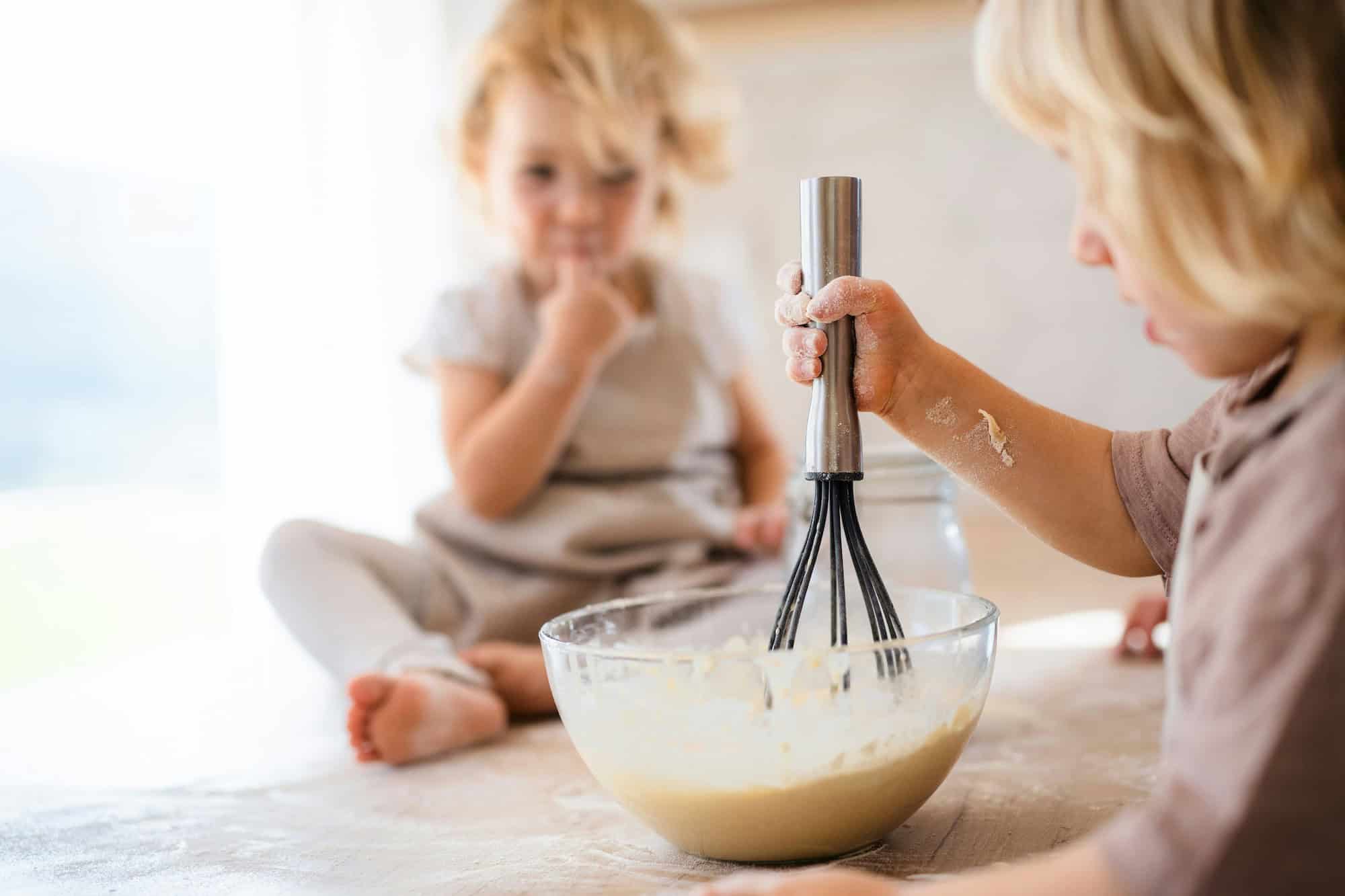
At this stage, toddlers are naturally curious and eager to explore. Their tasks should focus on simple and safe activities that help them feel included without overwhelming them.
Kitchen Tasks and Activities:
- Washing Fruits and Vegetables: Let them rinse fruits and vegetables under cold water. If you have a kitchen learning tower, you can move that up to the sink and let your child go to work! This is a great way to introduce them to different textures and colours of produce.
- Tearing Lettuce or Herbs: Tearing is fun and safe for little hands. They can help make a salad by tearing lettuce or herbs like basil and mint.
- Mixing Ingredients: Use a big bowl and a sturdy spoon, allowing them to mix ingredients like pancake batter.
- Chopping foods using a child-safe cutter such as a crinkle cutter or child-safe knife. Children can help cut up some food items with supervision. I love the Montessori Kitchen Tools Set.
- Placing Items: Let them place muffin liners in the muffin tin or set the table with napkins, or unbreakable dishes.
Recipe Ideas for Toddlers Ages 2-3 years old:
- Fruit & Yogurt Parfait: Layer yogurt and cut up fruit into a clear cup or child safe bowl. Add a sprinkle of soft, child safe granola or some hemp hearts on top!
- Mini Snack Place: Set up some small pieces of cheese, fruit, crackers and hummus and have your child arrange on a plate!
- Veggie Pinwheels: Spread a soft tortilla with some cream cheese and let your child sprinkle shredded carrots, shredded cucumber and some cheese. Then you can roll it up together and slice it with a child safe knife.
Safety Tips:
- Always supervise toddlers closely.
- Use child-safe utensils.
- Keep hot and sharp objects out of reach.
Kitchen Activities for Preschoolers (Ages 4-5)
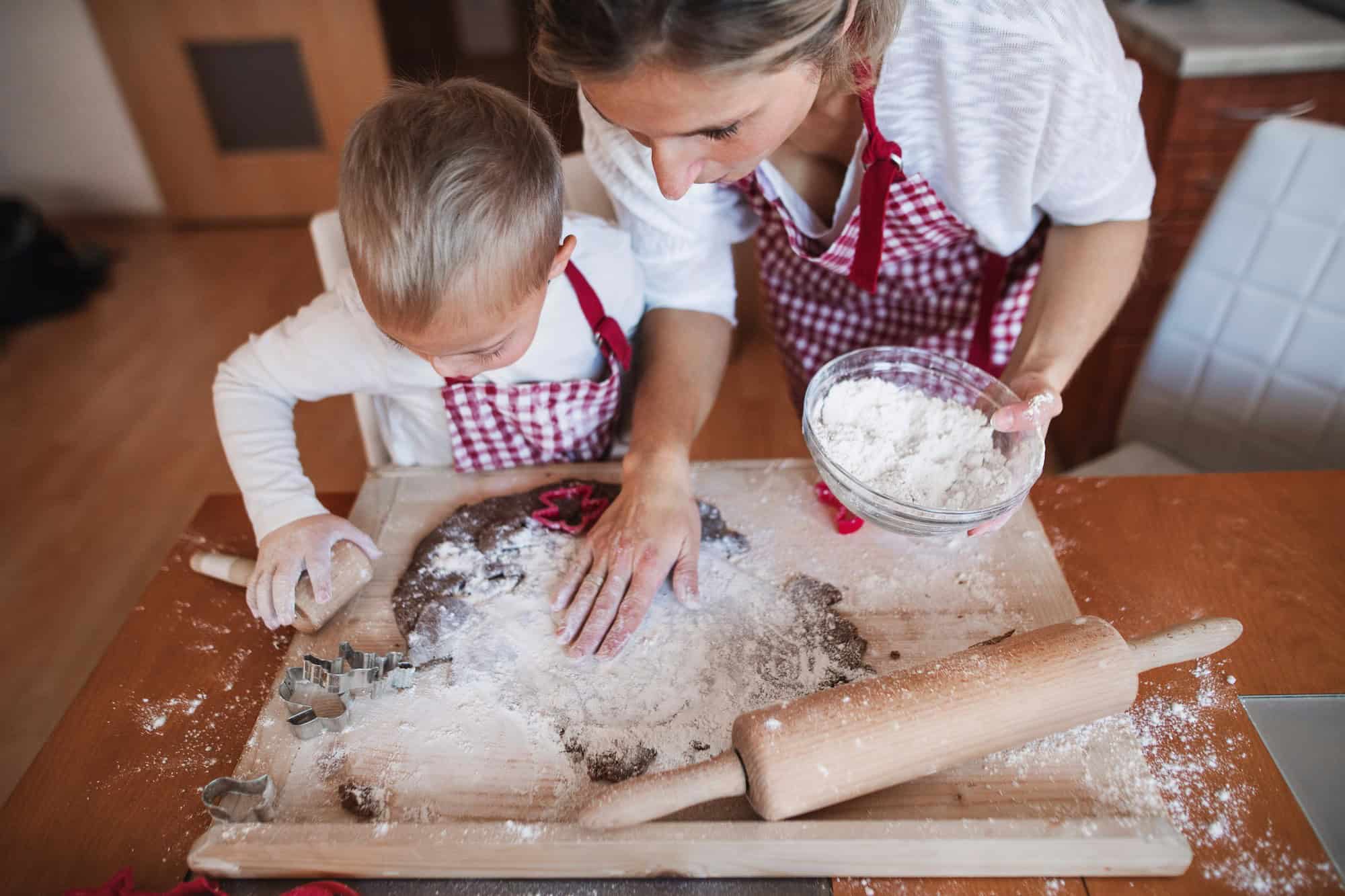
Preschoolers can handle more detailed tasks that require a bit more focus. Their growing motor skills and concentration allow them to take on slightly more complex activities.
Kitchen Tasks and Activities:
- Measuring and Pouring: Teach them to measure dry and liquid ingredients and pour them into bowls.
- Stirring and Whisking: They can stir sauces, soups, or batters with a whisk or spoon.
- Peeling: Use a child-safe peeler to peel bananas or oranges.
- Cutting Soft Foods: With a plastic knife or crinkle cutter, let them cut soft foods like bananas, strawberries, or cheese.
- Cracking Eggs: Show them how to crack eggs into a bowl, teaching them to be gentle and careful. You can also start to talk to your child about food safe around foods such as raw eggs.
Recipe Ideas for Preschoolers ages 4-5 years old:
- Mini Pizzas: Provide small pieces of pita or English muffins for them to top with sauce, shredded cheese, and pre-chopped veggies.
- Banana Pancakes: Mix pancake batter with mashed bananas. They can mash the banana and stir the batter together. They’ll love seeing their creations cook!
- Energy Bites or Bars: Show them how to mix oats, nut butter (or sunflower butter), maple syrup, and add-ins like chocolate chips or raisins. Then, let them help roll the mixture into small balls.
Safety Tips:
- Use age-appropriate, child-friendly kitchen tools.
- Provide step-by-step instructions and model tasks before asking them to try.
- Maintain supervision to ensure safe practices.
Kitchen Activities for Early School Age (Ages 6-8)
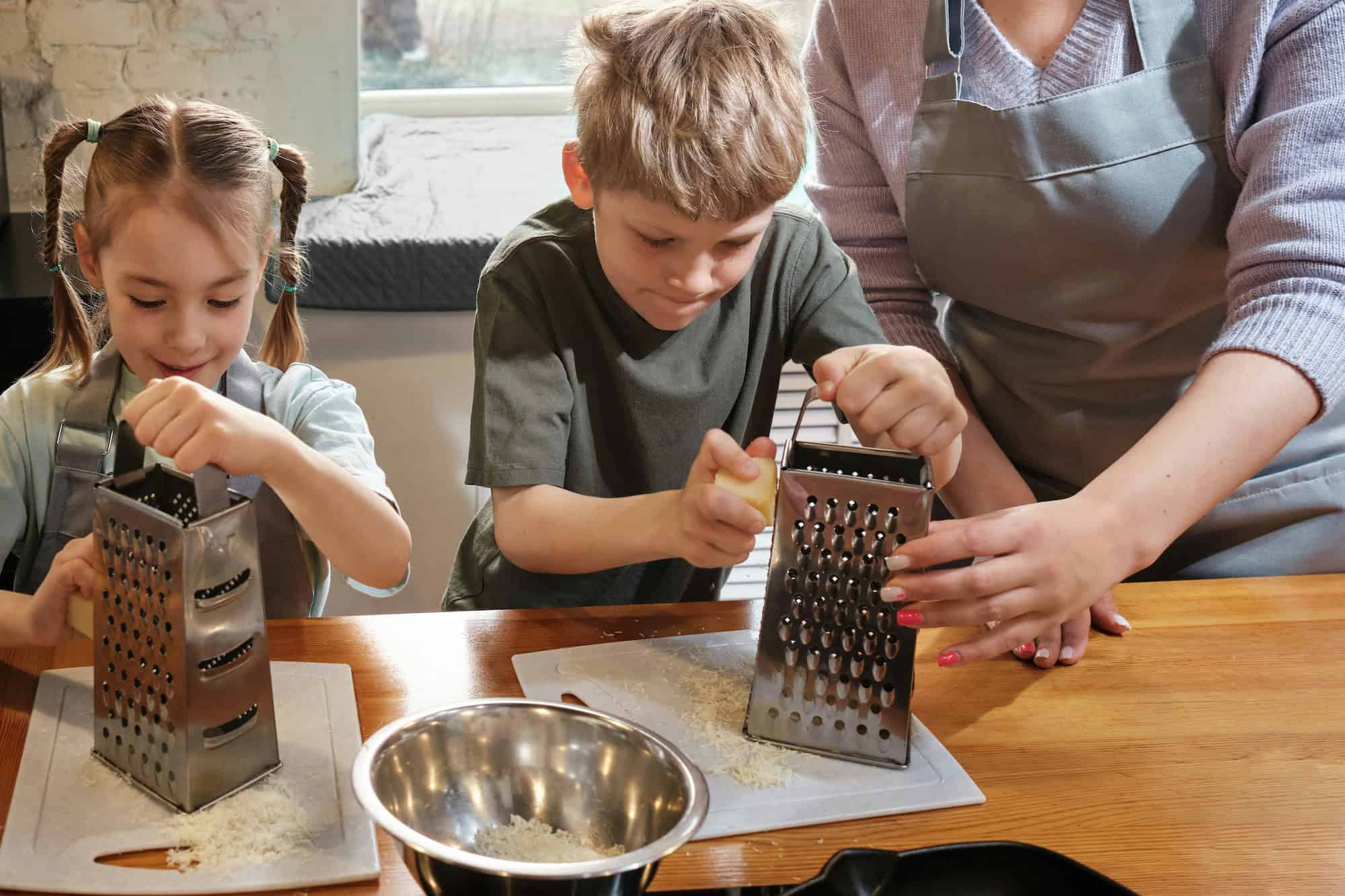
Children in this age group have improved coordination and can follow multi-step instructions, making them capable of handling more complex kitchen tasks.
Kitchen Tasks and Activities:
- Reading Recipes: Encourage them to read simple recipes aloud, fostering reading skills and understanding of instructions.
- Grating and Slicing: With supervision, allow them to grate cheese or slice vegetables using a child-safe knife.
- Mixing and Kneading Dough: Let them mix and knead dough for bread or cookies, teaching them about texture and consistency.
- Using Small Appliances: With guidance, they can use blenders or mixers for smoothies or cake batters.
- Assembling Dishes: Have them layer ingredients for a lasagna or assemble their own sandwiches and pizzas.
Recipe Ideas for ages 6-8 years old:
- Taco Bowls: Set up a taco bar with rice, beans, chopped veggies, and cheese. They can assemble their own bowl and personalize it to their taste.
- Veggie – Pasta Salad: Have them cook pasta with supervision, then toss in chopped veggies, cheese, and a simple dressing for a colourful and balanced dish.
- Simple Stir-Fry: With a bit of guidance, they can stir-fry pre-cut veggies and tofu or chicken in a pan. Add rice or noodles, and they have a complete meal they helped create
Safety Tips:
- Teach them to handle appliances safely, explaining potential hazards.
- Encourage them to clean up as they go to maintain a tidy workspace.
- Supervise closely, especially when they use sharp objects or appliances.
- For raw meat, you as the parent can still lead this but you can start to talk to your child about food safety around these foods.
Kitchen Activities for Preteens (Ages 9-12)

Preteens are ready to take on more responsibility in the kitchen. They can understand recipes, manage more complex tasks, and even start cooking some dishes independently.
Kitchen Tasks and Activities:
- Planning and Preparing Meals: Encourage them to plan a simple meal, considering ingredients and cooking times.
- Using the Stove and Oven: Teach them to use the stove and oven safely, emphasizing the importance of oven mitts and timers.
- Experimenting with Flavours: Allow them to experiment with spices and seasonings, developing their palate and creativity.
- Cooking Full Dishes: Guide them in cooking full meals, like pasta, stir-fry, or baked goods.
- Food Presentation: Encourage them to plate food attractively, considering colors and textures.
Recipe Ideas for ages 9-12 years:
- Homemade Quesadillas: Let them fill tortillas with cheese, beans, and other toppings, then cook them on a griddle with supervision.
- Stuffed Peppers: With a bit of guidance, they can hollow out bell peppers and fill them with a mixture of rice, beans, cheese, and seasonings, then bake until tender.
- Baked Granola Bars: Have them mix oats, honey, and add-ins like nuts or chocolate chips, then press into a pan and bake. These make a healthy, homemade snack they can enjoy all week!
Safety Tips:
- Emphasize the importance of kitchen safety, including handling hot dishes and sharp knives.
- Discuss food safety for specific foods such as raw meats.
- Encourage them to ask for help when needed.
- Instill good hygiene practices, like washing hands and cleaning up spills immediately.
Conclusion
Celebrate with your child once you’ve made something! Your child is going to be so proud of their contribution. Honour that with them!
Including toddlers and kids in the kitchen is such an amazing way to build a positive relationship with food. It encourages curiosity with food, boosts confidence, and provides an opportunity for family bonding. By providing age-appropriate tasks, you can ensure your children are safe while developing valuable life skills.
Whether they’re washing veggies or planning a meal, involving your little ones in cooking can transform mealtime into a cherished family activity. So, roll up your sleeves, grab your aprons, and enjoy cooking with your kids!

